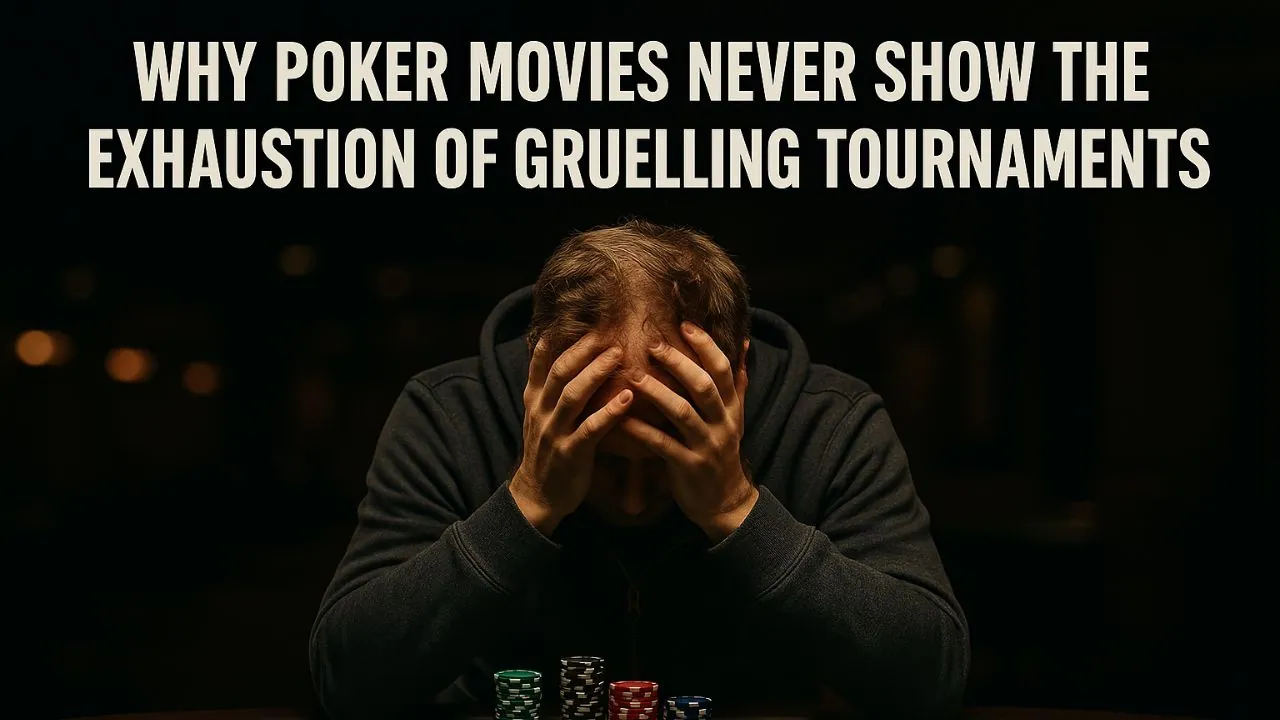Movies love to show the final table. A dramatic river card lands, the hero rakes in chips, and the audience gets a clean storyline. But poker tournaments aren’t scripted. The reality is long hours, small pots, grinding through levels, and stretches where nothing happens. Hollywood condenses three days of hard-fought poker into a few hands. Filmmakers typically opt for quick flashes of drama and big bets that fit neatly into a two-hour movie.
Table of Contents
Long Hours and Mental Fatigue
Poker scenes in movies capture dramatic all-ins and impossible bluffs but ignore the grind of multi-day poker events. These tournaments stretch for 10 to 12 hours daily. Players battle exhaustion, dwindling focus, and the pressure of increasing blinds. What looks like a quick montage on screen is often five days of mental warfare.
A deep run in the WSOP Main Event or other high-stakes poker event means surviving countless hands, bad beats, and stretches of unplayable cards. The tension builds from managing fatigue across hundreds of hands.
Even more taxing is the constant focus required. Reading opponents, managing chip stacks, recalculating pot odds — doing this day after day becomes mentally draining. There’s no background music to keep things exciting. Just the sound of riffling chips and internal monologues trying to avoid tilt.
Sleep Deprivation Changes Everything
A poker tournament can stretch across multiple days with only a few hours of rest in between. Some players have been running on five hours of sleep per night by the time they reach the final table. What happens when fatigue kicks in? Mistakes. In a movie, a player always has the right read. In real tournaments, even elite players miscalculate ranges and make hero calls they shouldn’t because exhaustion clouds judgment.
Sleep deprivation dulls decision-making and slows reaction time. A single misread or missed value bet caused by fatigue can turn into a lost stack. It’s not about dramatics — it’s about attrition. Mental sharpness fades, and the tournament punishes anyone who loses their edge.
The Reality of Sitting Through Card Dead Hours
Every hand is dramatic in movies that feature poker. Someone shoves, a vital card appears, and stacks shift. Real tournaments don’t play that way. Players can fold for hours while waiting for something playable. The actual grind is staying patient when the best option is discarding one bad hand after another while everyone else gets involved in pots. Hollywood rarely shows a player folding queen-jack offsuit for the seventh time in a row while the blinds eat away at their stack.
Sometimes, staying card dead while others accumulate chips isn’t just boring — it’s psychologically brutal. The patience required to stay composed and not chase losses or overextend grows thinner with each orbit.
Emotional Drain Costs More Than Chips
Movies simplify poker into logic and perfect timing. However, actual tournament players deal with frustration, egos, bad beats, and bankroll swings. A single painful hand can derail someone for hours if they don’t regain focus. Losing a big pot late in the tournament means quickly resetting mentally or risking further collapse. This is never in the script. Instead, every movie pro shrugs off setbacks effortlessly.
In real life, it’s common to see players lose their temper, go on tilt, or spiral into overly aggressive play after a setback. Emotional resilience becomes as important as reading the board or understanding position. As pro player Daniel Negreanu once noted, “Poker is a game of people played with cards, not a game of cards played with people.”
Physical Endurance Is a Factor
Hollywood disregards the physical impact of tournament poker. Sitting for extended periods strains the body. Sitting for 10-hour sessions while maintaining focus is harder than it seems. Tournament players deal with stiff backs, sore necks, and fatigue from sitting in one spot all day. Nutrition, hydration, and basic posture become a factor in later stages. Hollywood skips straight to the action and ignores the reality of players stretching between hands and battling physical wear as much as mental strain.
Some players even train physically to be in shape for high-stakes tournament weeks. Just like athletes, they recognize that a healthy body helps sustain a sharp mind. There’s little glamour in stretching at the table or snacking on almonds, but it’s part of what separates those who last from those who crack.
Poker Movies Chase Drama, Not Accuracy
Slowing down poker for realism does not suit entertainment purposes. Films favor exaggerated personalities and quick-moving hands. The slow burn of an actual poker tournament doesn’t make for engaging cinema. The long grind, exhaustion, and mental battles don’t fit into clean three-act structures. The reality is tougher, slower, and demands endurance that never reaches the screen.
Conclusion: Behind the Final Table Fantasy
While poker movies serve up satisfying climaxes and cinematic chip stacks, they rarely reflect the real-world grind of tournament poker. The truth hides in the hours of folding, the aches of ten-hour sits, and the inner battle against tilt and fatigue. These aren’t flashy moments, but they define the journey. Real tournament poker is a test of mental, physical, and emotional endurance. The next time a movie hero goes from zero to bracelet winner in two scenes, remember: in reality, that win likely came after five days of discomfort, discipline, and unglamorous resilience. That’s the real drama — and it never makes the cut.

